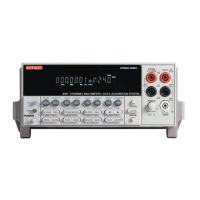3-28 Basic DMM Operation Model 2701 User’s Manual
Ratiometric method
For the 10MΩ and 100MΩ ranges, the ratiometric method is used to measure resistance.
Test current for this method is generated by a 0.7µA current source (I
SOUR
) in parallel
with a 10MΩ reference resistance (R
REF
) as shown in Figure 3-11.
Basic circuit theory dictates that the sum of the branch currents (I
REF
and I
DUT
) is equal to
the source current (I
SOUR
). Since the voltmeter of the Model 2701 (V
MEAS
) has very high
input impedance (>10GΩ), current through the voltmeter branch is insignificant and can
be discounted. Therefore, as shown in Eq. 1, I
SOUR
= I
REF
+ I
DUT
.
Since I = V/R, Eq. 1 is modified using the V/R equivalents in place of I
REF
and I
DUT
.
Therefore:
I
SOUR
= (V
MEAS
/ R
REF
) + (V
MEAS
/ R
DUT
)
Eq. 1 is then rearranged to solve for R
DUT
and is shown in Eq. 2 of Figure 3-11. Keep in
mind that V
MEAS
is measured by the Model 2701. With V
MEAS
, I
SOUR
, R
REF
known, the
Model 2701 calculates the resistance of the DUT and displays the result.
NOTE Eq. 2 in Figure 3-11 assumes that R
REF
is exactly 10M
Ω
. In reality, the
Model 2701 “measures” the resistance of R
REF
and uses that value in the
equation. The Model 2701 routinely does a “self-calibration”. During this
process, the precision 0.7µA current is sourced through R
REF
with an open
input. This reference voltage (V
REF
) is measured and R
REF
is then calculated:
R
REF
= V
REF
/ 0.µ7
As shown in Figure 3-11B, the Ω4 function can also be used to measure ohms for the
10MΩ and 100MΩ ranges. There are actually 3-wire ohm measurements. Sense Hi is not
used. Figure 3-11B shows the Sense Hi terminal connected to the DUT but it does not
need to be. It can be left open.
The measurement method is similar to the ratiometric method for Ω2, but it performs an
extra voltage measurement (V
LEAD
) to compensate for IR drop in the input test leads. As
stated in the specifications (Appendix A) to achieve rated accuracy, the Input Hi and Input
Lo test leads must have 10% matching of resistance. To meet that criteria, simply use
similar type test leads that are the same length.
Keep in mind that V
MEAS
includes the voltage drops of the input test leads (Input Hi and
Input Lo). Therefore, the actual voltage drop across the DUT is V
MEAS
minus the two
voltage drops in the test leads.
Since matched input leads are used, the voltage drop for the two test leads are 2 x V
LEAD
.
Therefore; V
DUT
= V
MEAS
- 2(V
LEAD
).
The Model 2701 still uses Eq. 2 to calculate resistance, but it uses V
DUT
in place of
V
MEAS
. This ratiometric method cancels the effects of input test lead resistance.

